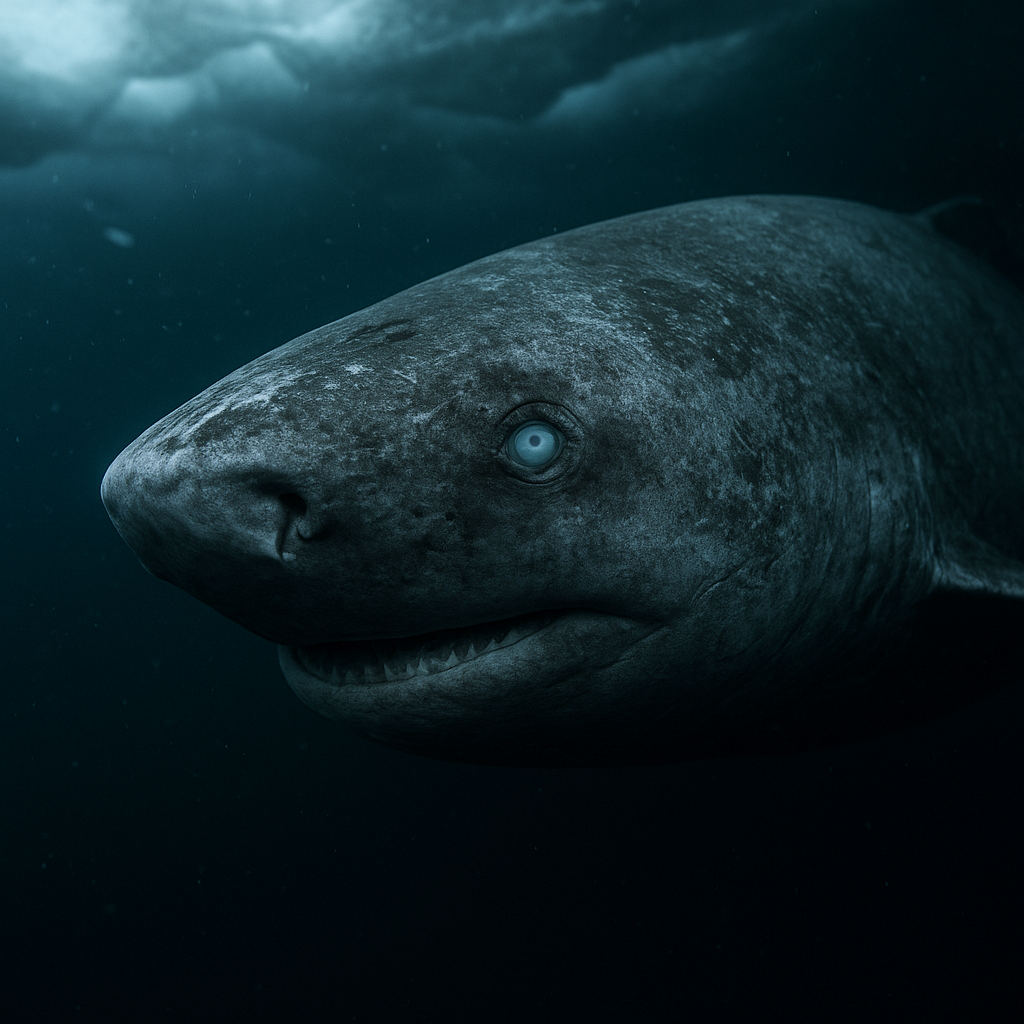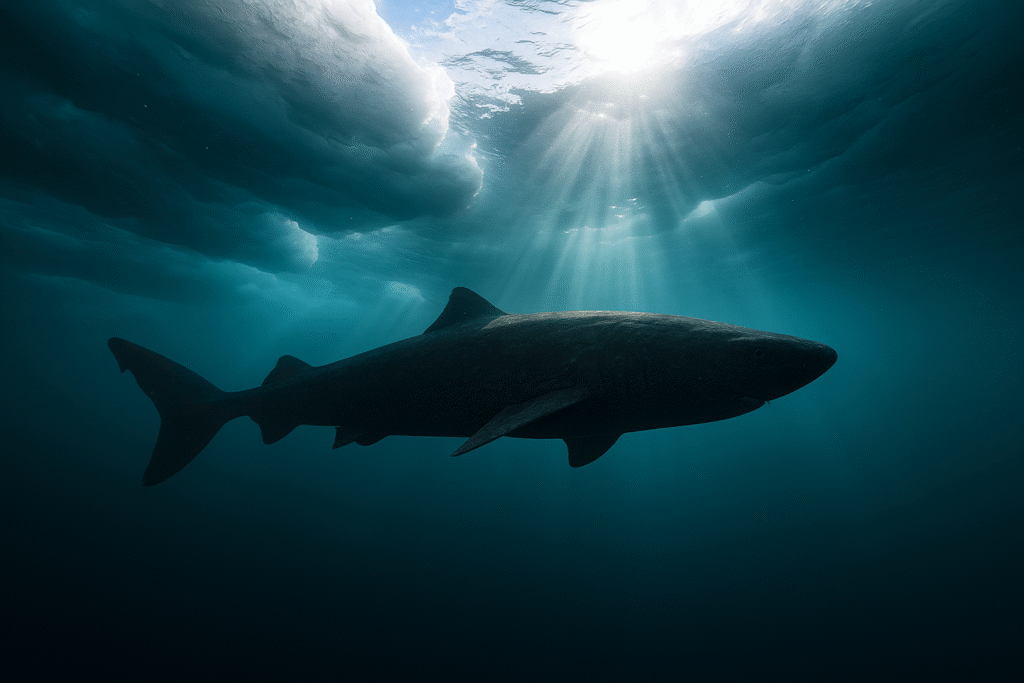In the world’s coldest oceans, far from coral reefs and sunlit shallows, there moves a creature older than empires, slower than glaciers, and more mysterious than any myth it inspired. The Greenland shark (Somniosus microcephalus) is not just a shark. It is a chronicle of time, a survivor of centuries, a living bridge between the ancient Earth and the present day.

Anatomy of a Ghost
At first glance, the Greenland shark is unremarkable compared to other marine giants. Its skin is gray to greenish, sometimes marbled, with a coarse, sandpaper-like texture. Many are scarred or host parasitic copepods that dangle like tattered veils from their corneas, rendering them almost blind. Yet in the abyss of the Arctic, where light cannot reach and vision is a luxury, blindness hardly matters.
They can grow to over 7 meters (23 feet) long, rivaling the great white, but lack the sleek speed of oceanic hunters. Instead, they move like shadows: slow, steady, unhurried. Evolution has given them flesh rich with trimethylamine oxide (TMAO), a natural antifreeze that prevents freezing at temperatures just above -1°C. The cost? Toxicity. Untreated flesh intoxicates humans in a state once described as “shark drunkenness.” Yet in the Arctic, where survival depended on ingenuity, Inuit peoples learned to ferment the flesh into food, a testament to resilience.
A Calendar Written in Flesh
The Greenland shark is the longest-living vertebrate known to science. Through radiocarbon dating of crystalline proteins in the eye lens—structures formed before birth and never replaced—scientists discovered that individuals live for 400 to perhaps 500 years.
That means some sharks alive today may have been born when Leonardo da Vinci sketched flying machines, when Martin Luther nailed his theses, when European ships first reached the Americas. These sharks have swum beneath Arctic ice while nations rose, collapsed, and disappeared from maps.
Their lifespan raises profound questions: What does survival look like when measured not in decades but in centuries? What memories—biological, ecological—are encoded in a creature that endures longer than human civilizations?
Predator, Scavenger, and Survivor
Despite their sluggish speed, Greenland sharks are predators. Their stomachs have revealed fish, seals, squid, and even land animals—reindeer, polar bears, and moose—likely scavenged when carcasses drifted into the sea. Their sense of smell is exquisitely tuned, allowing them to detect prey over vast distances, and their strategy is patience itself.
Unlike great whites, built for ambush and power, the Greenland shark hunts through persistence, conserving energy in the deep cold where every calorie counts. It is less a sprinter than a marathoner of eternity, proving that dominance in nature can arise from endurance rather than violence.
Legends from the North
Among Arctic peoples, the Greenland shark has always been a figure of awe. Inuit legends tell of sharks lurking beneath sea ice, ambushing seals at breathing holes. The shark’s toxic meat became both taboo and resource: dangerous, but with careful fermentation, life-saving in lean seasons.
Sailors feared it as a phantom of the deep. Its eerie, slow drift and parasitic “eye veil” gave rise to ghostly imagery, and its sheer size blurred the line between shark and sea monster. In Norse traditions, too, whispers of vast sea-beasts haunting icy fjords may have drawn inspiration from these sharks.

Even today, stories persist of Greenland sharks as time travelers, creatures that seem immune to mortality, embodying an oceanic memory older than our own.
The Fragility of the Ancient
Paradoxically, age makes the Greenland shark vulnerable. They grow at barely 1 centimeter per year and may not reproduce until reaching 150 years of age. Any sudden decline in population—from bycatch, habitat disruption, or climate change—could take centuries to repair, if ever.
Historically, the shark was hunted for its liver oil, used in lamps before petroleum replaced it. Though targeted hunts have declined, modern dangers remain: trawling nets, longlines, and the destabilization of Arctic ecosystems from warming seas.
In this light, the shark is a mirror of ourselves. If an animal that survived centuries of ice ages, wars, and industrial revolutions can be imperiled by a few decades of human carelessness, what does that say about our stewardship of the planet?
The Philosophy of Slowness
The Greenland shark invites us to reconsider our obsession with speed, growth, and immediacy. While other species thrive through agility, color, or aggression, the shark’s strategy is patience—slowness as survival.
It embodies the idea that to endure is to triumph. Its heart beats slowly; its movements are deliberate. Yet across centuries, it persists, outlasting countless generations of faster, flashier creatures, including human witnesses who marvel at its mystery.
In its endurance lies a quiet philosophy: the power of persistence, the resilience of restraint, the wisdom of waiting.
Echoes in the Abyss
When divers and researchers glimpse a Greenland shark, the encounter feels like stepping back in time. Its eyes, clouded and scarred, seem to carry centuries within them. Its body, immense yet unhurried, moves like history itself through dark water.
In that moment, we are reminded that life is not just about dominance or brilliance, but about continuity—threads of existence that carry forward against all odds. The Greenland shark is not simply a fish; it is a living archive, a reminder that the past is still with us, gliding slowly beneath the Arctic ice.
Closing Reflection
The Greenland shark is a paradox: feared yet fragile, ancient yet endangered, ghostly yet real. It has endured ice ages and human empires, yet its fate now hangs in the balance of warming oceans and human care.

To save the Greenland shark is not only to protect a species. It is to preserve a piece of Earth’s memory, a voice from the deep that tells us: life can endure, if we allow it.


Reply